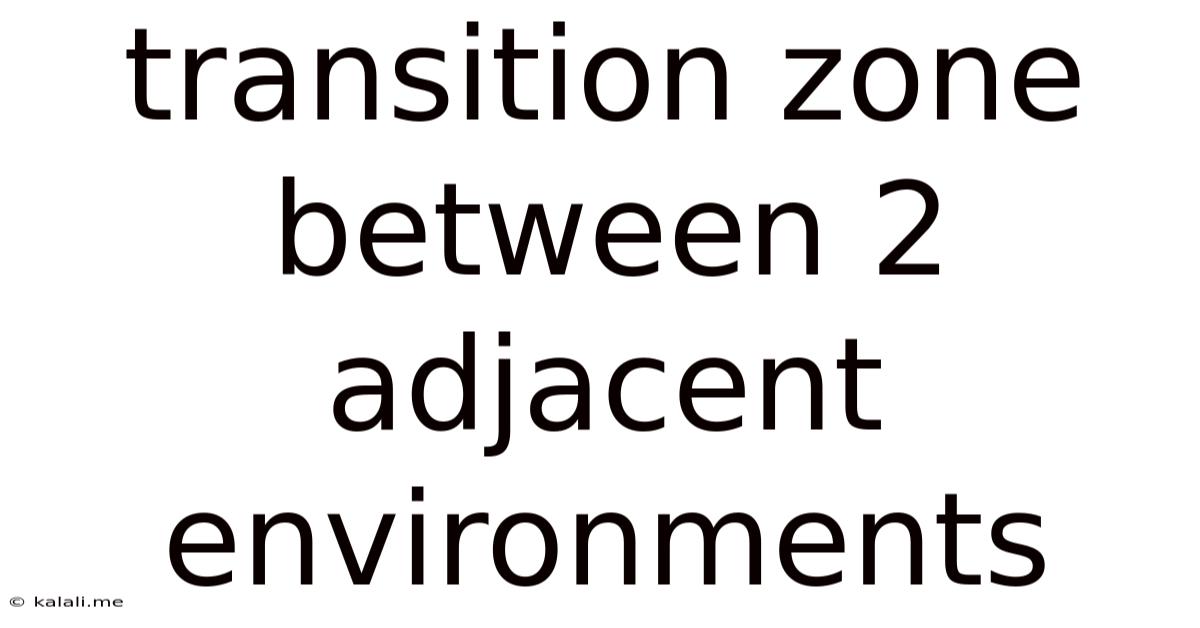Transition Zone Between 2 Adjacent Environments
Kalali
Jun 11, 2025 · 3 min read

Table of Contents
Transition Zones: Where Two Worlds Collide
Meta Description: Explore the fascinating world of transition zones, also known as ecotones, where two distinct environments meet and create unique ecosystems brimming with biodiversity. Learn about their characteristics, importance, and the challenges they face.
Transition zones, also known as ecotones, are fascinating areas where two adjacent ecosystems meet and intermingle. These areas are characterized by a high degree of biological diversity and unique ecological processes, often exhibiting characteristics of both bordering environments while also possessing distinct features of their own. Understanding these zones is crucial to comprehending the complex interactions within and between ecosystems.
Defining Characteristics of Transition Zones
Several key characteristics define transition zones:
-
Increased Biodiversity: Ecotones typically exhibit higher species richness and abundance than either of the adjacent ecosystems. This is because they provide a variety of habitats and resources, attracting species from both bordering environments, as well as specialized species adapted to the unique conditions of the ecotone itself. This increased biodiversity contributes significantly to ecosystem stability and resilience.
-
Edge Effects: The boundary between ecosystems creates unique conditions known as edge effects. These can include changes in microclimate, such as increased sunlight, wind, and temperature fluctuations. These alterations influence the distribution and abundance of species, often favoring those that thrive in open, exposed conditions.
-
Sharp or Gradual Transitions: The transition between ecosystems can be abrupt, forming a distinct boundary, or it can be gradual, creating a broader zone of overlap. The width and sharpness of the transition zone often depend on the physical and environmental factors involved. A riverbank, for example, might be a relatively sharp transition, whereas a forest-grassland ecotone could be a gradual shift over a considerable distance.
-
Unique Species Composition: Transition zones often support specialized species that are adapted to the specific conditions of the ecotone, and are not found in either of the adjacent ecosystems. These species may have evolved unique traits allowing them to exploit resources or withstand the challenges present at the boundary.
Examples of Transition Zones
Transition zones are found throughout the world and come in various forms, including:
-
Riparian Zones: The areas along rivers and streams where terrestrial and aquatic ecosystems meet. These zones are incredibly important for water quality, nutrient cycling, and biodiversity.
-
Forest-Grassland Ecotones: Where forests and grasslands meet, creating a mosaic of habitats with varying levels of tree cover and herbaceous vegetation.
-
Coastal Zones: The interface between land and sea, a dynamic environment characterized by tidal fluctuations, salinity gradients, and high levels of productivity.
-
Intertidal Zones: The area between high and low tide marks, supporting a rich diversity of organisms adapted to fluctuating water levels and salinity.
Importance of Transition Zones
Transition zones play a crucial role in ecosystem function and stability:
-
Habitat Provision: They offer diverse habitats supporting a wide range of species, contributing to overall biodiversity.
-
Nutrient Cycling: Ecotones are often sites of intense nutrient cycling, transferring resources between adjacent ecosystems.
-
Buffer Zones: They can act as buffer zones, mitigating the impact of disturbances on adjacent ecosystems.
-
Connectivity: Transition zones facilitate the movement of species and the flow of energy and nutrients between ecosystems, maintaining ecological integrity.
Challenges Facing Transition Zones
Despite their importance, transition zones face numerous challenges, including:
-
Habitat Fragmentation: Human activities like deforestation and urbanization can fragment transition zones, isolating populations and reducing biodiversity.
-
Invasive Species: Introduced species can outcompete native species, disrupting the delicate balance of the ecotone.
-
Climate Change: Changes in temperature and precipitation patterns can alter the characteristics of transition zones, affecting species composition and distribution.
-
Pollution: Runoff from agricultural lands and urban areas can pollute transition zones, negatively impacting water quality and biodiversity.
Understanding and protecting transition zones is essential for maintaining healthy and resilient ecosystems. Conservation efforts should focus on preserving the integrity of these unique and vital areas. Further research into the specific ecological processes within these areas is crucial to develop effective strategies for their long-term protection.
Latest Posts
Latest Posts
-
How Much Does A Gallon Oil Weigh
Jul 01, 2025
-
How Many Crackers In A Sleeve Of Saltines
Jul 01, 2025
-
How Many Years Are In 48 Months
Jul 01, 2025
-
What Grade Is A 12 Out Of 15
Jul 01, 2025
-
The Opposite Of The Opposite Of Inexact Is
Jul 01, 2025
Related Post
Thank you for visiting our website which covers about Transition Zone Between 2 Adjacent Environments . We hope the information provided has been useful to you. Feel free to contact us if you have any questions or need further assistance. See you next time and don't miss to bookmark.